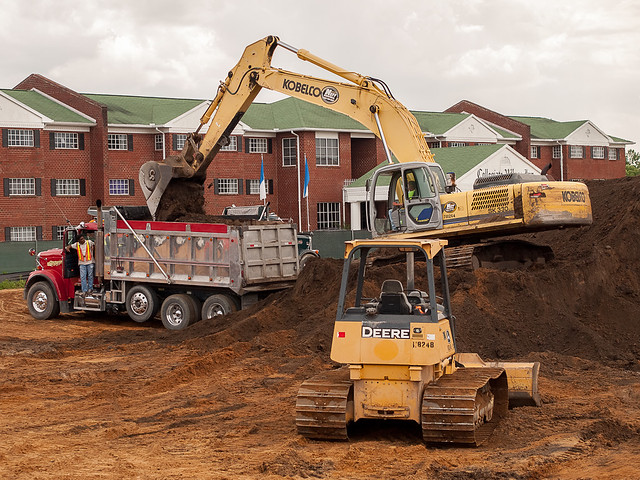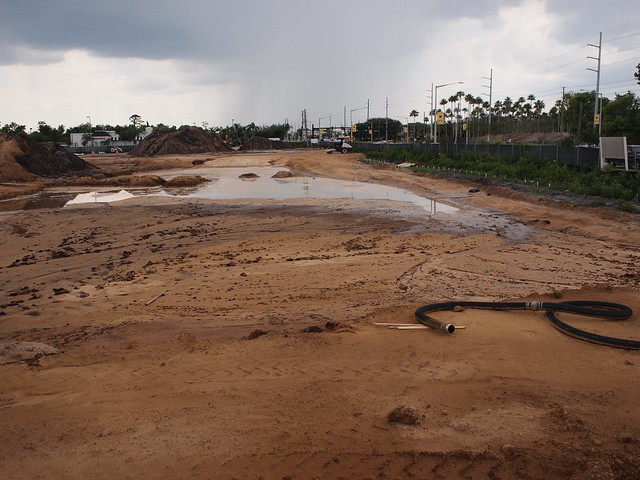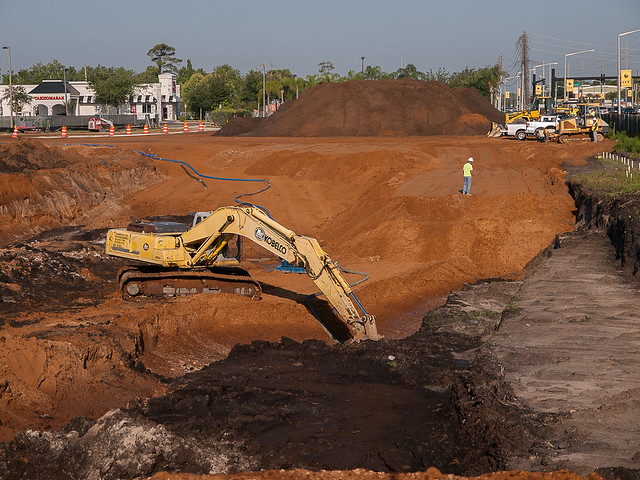A Friday with Two
It looks like they've pretty much finished up converting the once-forested property next to the Burger King into something flat and lifeless to build upon. There are large piles of dirt about the periphery, but it appears that the dirt is being moved off now. This was the only loader in operation, filling up dump trucks.
These two photographs, the upper taken today and the lower taken back on 8 May, give you an idea of the amount of dirt that was moved to fill the hole in the lower photo. The dark soil in the lower third of the 8 May photo was the original dark earth beneath the bit of woodlands and wetlands, with the orange soils being the orange soils being the part moved in and about. Recent heavy rains have flooded the now-flat and filled area. I have no idea what the hose in the foreground was used for, perhaps to pump water out of the lowered areas while they were filling in earlier in the week. I'm now curious when building construction will commence, and what magnificent structures will now rise from this empty and barren landscape.
A Mini Mini Mini Camera Review
Amazon and Cameta Camera have been selling Olympus E-PL1s, body only, for $150. I've been wanting for some time now to pick up a second µ4/3rds body to go along with my E-P2. I had thought to pick up a second E-P2 when it dropped to $220, but I dilly-dallied too long and the opportunity for picking up a second body at such a low price passed me by. Instead I purchased the even lower priced E-PL1, thinking that at that price I had nothing much to loose.
The E-PL1 has its share of oddities and "design sins" if you will, but a price of $150 will cover all oddities and forgive all sins. To be honest the so-called oddities and sins are minor. The E-PL1 it has one significant feature that stands out from the E-P2. I have noted since purchasing the E-P2 that the screen and EVF display considerable vertical noise in low light situations, making it almost unusable if the light level is low enough. The E-PL1 does not display this noise. I can point both cameras at the same low level scene and the image on the back of E-PL1 is clearer than the exact same scene on the back of the E-P2. Oddly enough this makes the E-PL1 a better choice for low-light work than the E-P2.
The E-PL1 also seems to focus slightly faster than the E-P2 with µ4/3rds lenses, but not so much that I'd reach for the E-PL1 over the E-P2. However faster the E-PL1 might be, it's still lethargically slow with regular 4/3rds lenses mounted via the MMF-2 or DMW-MA1 adapters.
Two things I quickly found I don't like about the E-PL1 are the art filters and in-camera processing, especially noise reduction. I found that with the exception of the pop-art filter, selecting any of the filters slows down the display of the image to make them infuriatingly unusable. With the E-P2 the processing was fast enough that the even diorama art filter was tolerable enough to experiment with. Not so with the E-PL1. In fact the E-PL1's are filters are so slow that I went into the monochrome settings in the menu and set it to sepia rather than use the gentle sepia art filter.
The second is in-camera processing. I tried to use the camera as a pure JPEG photo machine, with the idea of stripping my "work flow" down to a bare minimum where all I do is move the photo directly out of the camera to where it's eventually displayed (mostly the web). But I'd go and display an E-PL1 JPEG image on my notebook screen or tablet, and I'd see the "shard" type artifacts left by the Olympus in-camera noise reduction above ISO 200, and I'd grind my teeth.
I've spent too much time in the "lightroom". During the "film age" and my time in the darkroom I narrowed down to two favorite black and white films (Pan-X and Tri-X) and two favorite color films (Kodachrome 25 and 64). In the darkroom I eventually selected Ilford papers to print on (semi-matte black) and Cibachrome. This gave me the look to fit my tastes. In the digital world the equivalent is I've settled on Lightroom post-processing everything, especially with the release of Lightroom 4, to fit my tastes. Starting tomorrow I'm going to run raw with both cameras and post process everything in LR4.
Overall I've enjoyed working with both cameras. I have the M.Zuiko 17mm on the E-PL1 and the M.Zuiko 45mm on the E-P2. Walking about with two µ4/3rds cameras on both shoulders is far more inconspicuous than walking around with even one regular 4/3rds body. It's also considerably lighter. I carry the Panasonic 20mm in my shirt pocket, a couple of extra batteries, and I'm set for just about anything.
I have been told by more than one person that the sensor in the E-PL1 was "promoted" into the E-5, with the processor being the big difference between the two cameras. I find that a bit hard to believe, but I am curious to see how the E-PL1's raw images look. I'll find out this weekend.
In spite of the lack of any wheels on the E-PL1 I can still quickly get to and change what's necessary. For example I run the camera aperture priority, so changing the aperture is little more than hitting the +/- button (EV modify) and then hitting that button again to increase aperture or the opposite bottom bottom to decrease aperture. With the E-P2 it's more direct with the thumb wheel, but I don't change aperture that often so the difference is a wash. The obvious difference in physical interface is a challenge, but I'll get use to it the same way I got use to the differences between the E-1 and E-3.
Technical
Top photo taken with E-P2 and MZ 45mm, post processed in LR4. Middle photo taken with the E-PL1 and MZ 17mm, aperture preferred, base ISO, auto white balance, taken straight out of the camera. Bottom photo was taken with the E-3 and ZD 12-60mm, post processed in LR4.




Comments
Post a Comment
All comments are checked. Comment SPAM will be blocked and deleted.